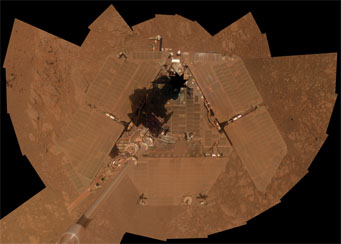The Opportunity rover fell silent in June after nearly 15 years of work on the Red Planet. Now the dust storm that prevented its batteries from charging is clearing.

NASA / JPL-Caltech / MSSS
NASA expects its long-running Opportunity Mars rover will wake up sometime in the next few weeks from its hibernation — if the rover has enough power to call back home.
Opportunity was in the middle of examining Perseverance Valley for signs of ancient water when a dust storm swept into the region in June. The storm came too quickly for NASA to move the rover to a more favorable position to charge its solar panels, so Opportunity stayed in place on a slope. No one has heard from the rover since June 10.
Skies are beginning to clear above Opportunity: the rover needs a certain atmospheric opacity (tau less than 2.0) to receive enough sunlight to charge, and while the tau was 10.8 back in June, it’s now hovering around 2–2.5 (updates provided here). So NASA has started listening in three times a week for any possible call. Opportunity is designed use the X-band radar frequency to get in touch with the Deep Space Network antennas that listen to spacecraft across the solar system. NASA's Jet Propulsion Laboratory is also sending commands to the rover in case it's listening.
Here's the challenge, though. Opportunity is most likely in what is called a "clock fault" mode, explains mission project manager John Callas (NASA JPL), which means the rover doesn't know what time it is. This can happen when the battery discharges too far. If there isn’t enough energy to sustain the charge on the batteries, the mission clock goes out. So NASA cannot predict when Opportunity will send calls to Earth, except to say it would be during local daytime, when the Sun is out.

NASA / JPL-Caltech / Cornell Univ. / Arizona State Univ.
Even if Opportunity is receiving enough solar power to charge up, its heater might be stuck on, which would eat up 180 watt-hours — most of the rover's minimum 250 watt-hour load to conduct normal operations. (NASA also allocates 40 watts for the mission clock and for "parasitic" charges from instruments, which are the electrical charges they draw even when powered off.) Generally, the rover goes into a deep sleep every night, which includes turning off the heater. "But if the rover is confused about what time it is, it doesn't know what time to deep sleep, and as a result that heater will be stuck," Callas explains.
Opportunity will need to wake up soon for its best chance of survival. Summer is fading in the rover’s region, which means the solar production potential is diminishing every day. When asked how long NASA would keep trying, Callas says he’s still trying to figure that out with his team. "But whatever that threshold is, we will then listen in for a period of time that gives us confidence that we should have heard something," he says.
Another big unknown is how much dust is on Opportunity’s solar panels. Just before the dust storm, the rover was drawing energy from two-thirds of its array surface. "It's possible it got cleaner, and also possible it got dirtier," Callas says, as dust may have been deposited on the solar panels or winds may have blown it off. "It's anyone's guess what the dust factor is."
The rover was originally designed to last only 90 days when it landed in Meridiani Planum on January 25, 2004, three weeks after its twin, Spirit, touched down in another location. Both rovers operated well past that expiry date. While Spirit permanently lost contact with NASA in 2010, Opportunity kept rolling past a marathon's worth of driving. Callas says that one of Opportunity's greatest legacies on its extended mission has been showing evidence of water everywhere in its region. "Not just puddles and ponds, but kilometer-scale bodies of water," he said.
Opportunity's current mission extends to October 1, 2019. If the rover turns out to be healthy enough to continue, Opportunity's team will submit another competitive proposal to NASA to further extend its mission by another three years to 2022.
 0
0









Comments
You must be logged in to post a comment.